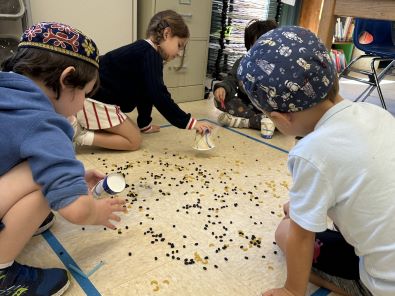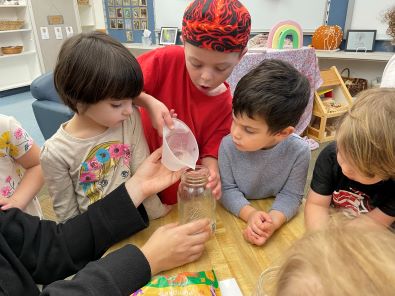Schechter Shavua: November 17, 2023
Owls Help Students Understand Skeletal Systems
 Middle School students were fearless and fascinated as they analyzed owl pellets in a recent science lesson. What is an Owl Pellet? Owls swallow their prey whole, therefore in addition to the meat that they digest for food, they also swallow other material such as bones, fur, or feathers. Because owls are unable to digest these materials, they are regurgitated in a compacted mass. This compacted mass of fur, bones, and any other indigestible material is called an owl pellet. Despite appearances, pellets are not owl poop.
Middle School students were fearless and fascinated as they analyzed owl pellets in a recent science lesson. What is an Owl Pellet? Owls swallow their prey whole, therefore in addition to the meat that they digest for food, they also swallow other material such as bones, fur, or feathers. Because owls are unable to digest these materials, they are regurgitated in a compacted mass. This compacted mass of fur, bones, and any other indigestible material is called an owl pellet. Despite appearances, pellets are not owl poop.
The students bravely dissected and identified the bones inside the owl pellet, then they made hypotheses as to which organisms the bones belonged. Students also constructed a food web with owls as secondary consumers.
Check out photos from many Schechter science lessons HERE!
Laying the Foundation For Biodiversity and Sustainability
 Our middle schoolers have been extremely busy in science class! They also created closed system terraria in order to see the material cycles in action. Because these terraria primarily highlight the water and carbon cycles, they also have a container of red wigglers (worms) and a couple of homemade leaf digesters so that they can see decomposition happen. Finally, students are growing lettuce hydroponically so that they can see that plants are made out of water and carbon dioxide, rather than soil. All these hands-on activities will help scaffold future discussions of biodiversity and sustainability.
Our middle schoolers have been extremely busy in science class! They also created closed system terraria in order to see the material cycles in action. Because these terraria primarily highlight the water and carbon cycles, they also have a container of red wigglers (worms) and a couple of homemade leaf digesters so that they can see decomposition happen. Finally, students are growing lettuce hydroponically so that they can see that plants are made out of water and carbon dioxide, rather than soil. All these hands-on activities will help scaffold future discussions of biodiversity and sustainability.
Passion for Science Blooms in Anafim(grades 1-2)
 The first and second grade students have been learning about seeds and all the parts of a plant. The students brought their learning to life by germinating bush beans (seeds) in a bag and watching all the parts of a plant grow. Each day they came to class, they opened their bags and used magnifying glasses to get a closer look at the roots, stems, and leaves growing from their bean. Once their plant had at least 2 leaves, they planted them in a cup.
The first and second grade students have been learning about seeds and all the parts of a plant. The students brought their learning to life by germinating bush beans (seeds) in a bag and watching all the parts of a plant grow. Each day they came to class, they opened their bags and used magnifying glasses to get a closer look at the roots, stems, and leaves growing from their bean. Once their plant had at least 2 leaves, they planted them in a cup.
Students have the responsibility of watering their young plants; this helps reinforce their knowledge about impact of climate on a variety of plants and the amount of water different varieties need to survive and thrive depending on their climate.
Which Beak is Best?
 The first-grade students of Anafimhave also been learning about plant and animal structures. In this lesson called “Find the Best Beak,” students investigated the relationship between the shape of different bird beaks and the food each bird eats. Using materials like straws and cups, students experimented with creating long pointy beaks that are great for picking up seeds and wide flat beaks that are optimal for scooping. They discovered that differently shaped beaks are better for different kinds of food.
The first-grade students of Anafimhave also been learning about plant and animal structures. In this lesson called “Find the Best Beak,” students investigated the relationship between the shape of different bird beaks and the food each bird eats. Using materials like straws and cups, students experimented with creating long pointy beaks that are great for picking up seeds and wide flat beaks that are optimal for scooping. They discovered that differently shaped beaks are better for different kinds of food.
Experimenting with the Effects of Different Liquids
 In science, Shorashim Bet (EC 3-4) asked the question: would a candy pumpkin change over time if it's put in different liquids? They created an experiment to answer their question. First, they filled three mason jars with different liquids: water, oil, vinegar; another jar remained empty, holding just air. The students took guesses about what ways the oil, water, and vinegar might change the pumpkins. As predicted, the jars with vinegar and water did change the pumpkins, completely dissolving the candy and leaving a colorful film floating in the jar. The pumpkin immersed in oil remained the same in appearance but felt "slimy" when touched. The students took tremendous pride in the experiment, actively observing the progress each day. These astute students concluded that the pumpkins immersed in vinegar and water dissolved because of the “make up” of each liquid!
In science, Shorashim Bet (EC 3-4) asked the question: would a candy pumpkin change over time if it's put in different liquids? They created an experiment to answer their question. First, they filled three mason jars with different liquids: water, oil, vinegar; another jar remained empty, holding just air. The students took guesses about what ways the oil, water, and vinegar might change the pumpkins. As predicted, the jars with vinegar and water did change the pumpkins, completely dissolving the candy and leaving a colorful film floating in the jar. The pumpkin immersed in oil remained the same in appearance but felt "slimy" when touched. The students took tremendous pride in the experiment, actively observing the progress each day. These astute students concluded that the pumpkins immersed in vinegar and water dissolved because of the “make up” of each liquid!
Reflections on the Israel Rally in Washington, DC
 In lieu of the usual d’var Torah, Rabbi Berger hopes that you will check out his latest blog post about the Israel rally in Washington, DC. Rabbi Berger, along with some Schechter middle school students and parents, was privileged to be part of the delegation organized by the Jewish Federation of Greater Hartford.
In lieu of the usual d’var Torah, Rabbi Berger hopes that you will check out his latest blog post about the Israel rally in Washington, DC. Rabbi Berger, along with some Schechter middle school students and parents, was privileged to be part of the delegation organized by the Jewish Federation of Greater Hartford.
Click HEREto read Rabbi Berger’s description of the Rally in Washington, DC
Solomon Schechter Day School
of Greater Hartford
26 Buena Vista Road
West Hartford, CT 06107
© Solomon Schechter Day School of Greater Hartford | Site design Knowles Kreative




